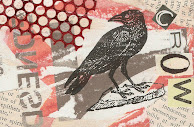I'm reading the new Sean Wilentz bio of Bob, a Christmas present from my husband David. It starts out tracing the roots of the liberal-lefty-Commie elements of American folk music, and surprisingly, it goes back to Aaron Copland. (In 1934, he won the Communist Song Award!)
It also turns out that Copland's young protege was Leonard Bernstein....and Clifford Odets and Elia Kazan were all part of this left wing group.
Pete Seeger's father, Charles was a folk music collector, along with John Lomax and his son, Alan. Pete Seeger dropped out of Harvard, and worked with Alan at the Library of Congress, where the Lomaxes created the Archive of American Folk Song. Alan discovered and recorded a young songwriter named Woody Guthrie, who then teamed up with Seeger and a group of folk artists to form the Almanac Singers. They promoted union organizing, racial justice, and other left wing causes. In the late 1940s, the Almanacs evolved into The Weavers, who had a number one hit with "Good Night Irene", which was a 1933 Leadbelly song discovered by the Lomaxes. The Weavers introduced the younger generation and Bob Dylan to the music of Woody Guthrie. Of course, Pete Seeger was named a "subversive", and the group was blacklisted. (The 1963 cover of Bob's album "Freewheelin" features him and his girlfriend Suze Rotolo, whose parents were New York City intellectuals and Communists, as well.)
This was all kind of news to me, the American Communist connection with folk music...though I knew about Pete Seeger & The Weavers being blacklisted. I wonder what it was about Communism that was so attractive during the 30s and 40s to all these artists, writers, and musicians. I guess it sounded good at the time...
Recently I was up late, and watched (for the 3rd or 4th time) the Martin Scorcese documentary "No Direction Home, which was divided in two parts so perfectly, and I was really primed to get this new biography. We just can't seem to get enough of Bob, from his folk period through his going-electric-mid-to-late 60s. It's all so brilliant, and he was just exploding with creativity. Was anyone ever as cool? No one could wear a checked suit & a top hat with more style. But then, I love his Rolling Thunder Review phase too, where he tours with Joan Baez, Roger McGuinn, Ramblin' Jack Elliott, and others. He was really our spokesperson, whether he liked it or not--we grew up with him, just like we did with The Beatles.
Tuesday, December 28, 2010
Friday, December 10, 2010
Collecting
I love vintage cards! These are the latest score from a Poughkeepsie junk shop on Route 9, and I got an entire box for $1. For some reason, they're easy to find, and they're usually really cheap. These are from the bottom end of the Christmas card market, and are kind of cheesy, but who can resist them? The Santa ones are all covered with dusty red flocking, and the kitten on the sled is a little pathetic. I like the dry brush style ornaments, they look very late 50s to me. The cards are all done by Whitman. I have some vintage paper dolls, and the Whitman ones are all done using this technique. I guess it was the style of their in house illustrators. Another detail: all the vintage Christmas cards I have are done on paper, as opposed to card stock, so it's pretty amazing that they've lasted this long, especially the ones from the 40s. And the box that these came in was from an old massage vibrator. It was so awful looking, that I actually decoupaged over it!
But, I do like the Eloise Wilkins style children dancing around Santa and riding on his sled... they're really pretty sweet.
But, I do like the Eloise Wilkins style children dancing around Santa and riding on his sled... they're really pretty sweet.
Subscribe to:
Posts (Atom)





